Land Use Changes, Disturbances, and Their Interactions on Future Forest Aboveground Biomass Dynamics in the Northern US
Abstract
:1. Introduction
2. Materials and Methods
2.1. Research Region
2.2. National Forest Inventory Data
2.3. Landsat Data
2.4. Description of the Matrix Models
2.5. Model Calibration and Validation
2.6. Land Use Change and Disturbance Scenarios
2.7. Fuzzy Sets representing LUC and Disturbance Uncertainty
2.8. Forest Vegetation Simulator Comparisons
3. Results
4. Discussion
4.1. Matrix Growth Models for Predicting Forest AGB Dynamics from 2018 to 2098
4.2. Backward Validation of Matrix Models from 2018 to 1998
4.3. Effects of LUC, Disturbances, and Their Interactions on Future Forest AGB Dynamics
4.4. Uncertainty Estimation
4.5. How Might We Increase the Forest AGB C Sink in the Northern US?
4.6. Future Work
5. Conclusions
Author Contributions
Funding
Acknowledgments
Conflicts of Interest
References
- Intergovernmental Panel on Climate Change (IPCC). Climate Change 2013: The Physical Science Basis. Working Group I Contribution to the IPCC 5th Assessment Report—Changes to the Underlying Scientific/Technical Assessment; Cambridge University Press: New York, NY, USA, 2013. [Google Scholar]
- Law, B.E.; Hudiburg, T.W.; Berner, L.T.; Kent, J.J.; Buotte, P.C.; Harmon, M.E. Land use strategies to mitigate climate change in carbon dense temperate forests. Proc. Natl. Acad. Sci. USA 2018, 115, 3663–3668. [Google Scholar] [CrossRef] [PubMed] [Green Version]
- Schurman, J.S.; Trotsiuk, V.; Bače, R.; Čada, V.; Fraver, S.; Janda, P.; Kulakowski, D.; Labusova, J.; Mikoláš, M.; Nagel, T.A.; et al. Large-scale disturbance legacies and the climate sensitivity of primary Picea abies forests. Glob. Chang. Biol. 2018, 24, 2169–2181. [Google Scholar] [CrossRef] [PubMed]
- Domke, G.M.; Walters, B.F.; Nowak, D.J.; Smith, J.E.; Ogle, S.M.; Coulston, J.W. Greenhouse Gas Emissions and Removals from Forest Land and Urban Trees in the United States, 1990–2017; Resource Update FS-178; Department of Agriculture, Forest Service, Northern Research Station: Newtown Square, PA, USA, 2019; 4p. [Google Scholar]
- Woodall, C.W.; Walters, B.F.; Coulston, J.W.; D’Amato, A.W.; Domke, G.M.; Russell, M.B.; Sowers, P.A. Monitoring network confirms land use change is a substantial component of the forest carbon sink in the eastern United States. Sci. Rep. 2015, 5, 17028. [Google Scholar] [CrossRef] [PubMed]
- Wear, D.N.; Coulston, J.W. From sink to source regional variation in US forest carbon futures. Sci. Rep. 2015, 5, 16518. [Google Scholar]
- Yu, Z.; Lu, C.; Cao, P.; Tian, H. Long-term terrestrial carbon dynamics in the Midwestern United States during 1850–2015: Roles of land use and cover change and agricultural management. Glob. Chang. Biol. 2018, 24, 2673–2690. [Google Scholar] [CrossRef] [PubMed]
- Ramankutty, N.; Foley, J.A. Estimating historical changes in land cover: North American croplands from 1850 to 1992: GCTE/LUCC RESEARCH ARTICLE. Glob. Ecol. Biogeogr. 1999, 8, 381–396. [Google Scholar] [CrossRef]
- Houghton, R.A.; House, J.I.; Pongratz, J.; Van Der Werf, G.R.; DeFries, R.S.; Hansen, M.C.; Quéré, C.L.; Ramankutty, N. Carbon emissions from land use and land-cover change. Biogeosciences 2012, 9, 5125–5142. [Google Scholar] [CrossRef] [Green Version]
- Caspersen, J.P.; Pacala, S.W.; Jenkins, J.C.; Hurtt, G.C.; Moorcroft, P.R.; Birdsey, R.A. Contributions of land-use history to carbon accumulation in US forests. Science 2000, 290, 1148–1151. [Google Scholar] [CrossRef]
- Albani, M.; Medvigy, D.; Hurtt, G.C.; Moorcroft, P.R. The contributions of land-use change, CO2 fertilization, and climate variability to the Eastern US carbon sink. Glob. Chang. Biol. 2006, 12, 2370–2390. [Google Scholar] [CrossRef]
- Ollinger, S.V.; Aber, J.D.; Reich, P.B.; Freuder, R.J. Interactive effects of nitrogen deposition, tropospheric ozone, elevated CO2 and land use history on the carbon dynamics of northern hardwood forests. Glob. Chang. Biol. 2002, 8, 545–562. [Google Scholar] [CrossRef]
- Houghton, R.A. Revised estimates of the annual net flux of carbon to the atmosphere from changes in land use and land management 1850–2000. Tellus B 2003, 55, 378–390. [Google Scholar]
- Houghton, R.A. Aboveground forest biomass and the global carbon balance. Glob. Chang. Biol. 2005, 11, 945–958. [Google Scholar] [CrossRef]
- Ma, W.; Liang, J.; Cumming, J.R.; Lee, E.; Welsh, A.B.; Watson, J.V.; Zhou, M. Fundamental shifts of central hardwood forests under climate change. Ecol. Model. 2016, 332, 28–41. [Google Scholar] [CrossRef] [Green Version]
- Ma, W.; Zhou, M. Assessments of harvesting regimes in central hardwood forests under climate and fire uncertainty. For. Sci. 2017, 64, 57–73. [Google Scholar] [CrossRef]
- Seidl, R.; Thom, D.; Kautz, M.; Martin-Benito, D.; Peltoniemi, M.; Vacchiano, G.; Wild, J.; Ascoli, D.; Petr, M.; Honkaniemi, J.; et al. Forest disturbances under climate change. Nat. Clim. Chang. 2017, 7, 395. [Google Scholar] [CrossRef] [PubMed]
- Nabuurs, G.J.; Schelhaas, M.J.; Mohren, G.M.; Field, C.B. Temporal evolution of the European forest sector carbon sink from 1950 to 1999. Glob. Chang. Biol. 2003, 9, 152–160. [Google Scholar] [CrossRef]
- Kurz, W.A.; Stinson, G.; Rampley, G.J.; Dymond, C.C.; Neilson, E.T. Risk of natural disturbances makes future contribution of Canada’s forests to the global carbon cycle highly uncertain. Proc. Natl. Acad. Sci. USA 2008, 105, 1551–1555. [Google Scholar] [CrossRef]
- Breshears, D.D.; Allen, C.D. The importance of rapid, disturbance-induced losses in carbon management and sequestration. Glob. Ecol. Biogeogr. 2002, 11, 1–5. [Google Scholar] [CrossRef]
- Easterling, D.R.; Meehl, G.A.; Parmesan, C.; Changnon, S.A.; Karl, T.R.; Mearns, L.O. Climate extremes: Observations, modeling, and impacts. Science 2000, 289, 2068–2074. [Google Scholar] [CrossRef]
- Smith, T.M.; Shugart, H.H. The transient response of terrestrial carbon storage to a perturbed climate. Nature 1993, 361, 523. [Google Scholar] [CrossRef]
- Kirilenko, A.P.; Solomon, A.M. Modeling dynamic vegetation response to rapid climate change using bioclimatic classification. Clim. Chang. 1998, 38, 15–49. [Google Scholar] [CrossRef]
- Alexander, P.; Rabin, S.; Anthoni, P.; Henry, R.; Pugh, T.A.; Rounsevell, M.D.; Arneth, A. Adaptation of global land use and management intensity to changes in climate and atmospheric carbon dioxide. Glob. Chang. Biol. 2018, 24, 2791–2809. [Google Scholar] [CrossRef] [PubMed] [Green Version]
- Krause, A.; Pugh, T.A.; Bayer, A.D.; Li, W.; Leung, F.; Bondeau, A.; Doelman, J.C.; Humpenöder, F.; Anthoni, P.; Bodirsky, B.L. Large uncertainty in carbon uptake potential of land-based climate-change mitigation efforts. Glob. Chang. Biol. 2018, 24, 3025–3038. [Google Scholar] [CrossRef] [PubMed]
- Ma, W.; Woodall, C.; Domke, G.; D’Amato, A.; Walters, B. Stand age versus tree diameter as a driver of forest carbon inventory simulations in the northeast U.S. Can. J. For. Res. 2018, 480, 1135–1147. [Google Scholar] [CrossRef]
- Ma, W.; Domke, G.; D’Amato, A.; Woodall, C.; Walters, B.; Deo, R. Using matrix models to estimate aboveground forest biomass dynamics in the Eastern USA through various combinations of LiDAR, Landsat, and forest inventory data. Environ. Res. Lett. 2018, 13, 125004. [Google Scholar] [CrossRef]
- Lewis, E.G. On the Generation and Growth of a Population in Mathematical Demography; Springer: Berlin/Heidelberg, Germany, 1942; pp. 221–225. [Google Scholar]
- Leslie, P.H. On the use of matrices in certain population mathematics. Biometrika 1945, 33, 183–212. [Google Scholar] [CrossRef]
- Crookston, N.L.; Dixon, G.E. The forest vegetation simulator: A review of its structure, content, and applications. Comput. Electron. Agric. 2005, 49, 60–80. [Google Scholar] [CrossRef]
- Dymond, C.C.; Scheller, R.M.; Beukema, S. A new model for simulating climate change and carbon dynamics in forested landscapes, British Columbia. J. Ecosyst. Manag. 2002, 13, 1–2. [Google Scholar]
- Parton, B.; Ojima, D.; Del Grosso, S.; Keough, C. CENTURY Tutorial. Supplement to CENTURY User’s Manual; Colorado State University: Fort Collins, CO, USA, 2001. [Google Scholar]
- Schelhaas, M.J.; van Esch, P.W.; Groen, T.A.; de Jong, B.H.J.; Kanninen, M.; Liski, J.; Masera, O.; Mohren, G.M.J.; Nabuurs, G.J.; Palosuo, T.; et al. CO2FIX V 3.1 A Modelling Framework for Quantifying Carbon Sequestration in Forest Ecosystems (No. 1068); Alterra-Centrum Ecosystemen: Wageningen, The Netherlands, 2004. [Google Scholar]
- Kurz, W.A.; Dymond, C.C.; White, T.M.; Stinson, G.; Shaw, C.H.; Rampley, G.J.; Smyth, C.; Simpson, B.N.; Neilson, E.T.; Trofymow, J.A.; et al. CBM-CFS3: A model of carbon-dynamics in forestry and land-use change implementing IPCC standards. Ecol. Model. 2009, 220, 480–504. [Google Scholar] [CrossRef]
- Buongiorno, J.; Michie, B.R. A matrix model of uneven-aged forest management. For. Sci. 1980, 26, 609–625. [Google Scholar]
- Picard, N.; Bar-Hen, A.; Guédon, Y. Modelling diameter class distribution with a second-order matrix model. For. Ecol. Manag. 2003, 180, 389–400. [Google Scholar] [CrossRef]
- Rao, C.R. Linear Statistical Inference and Its Applications; John Wiley: New York, NY, USA, 1973. [Google Scholar]
- Albert, A.; Anderson, J.A. Probit and logistic discriminant functions. Commun. Stat.-Theory Methods 1981, 10, 641–657. [Google Scholar] [CrossRef]
- Tobin, J. Estimation of relationships for limited dependent variables. Econom. Soc. 1958, 26, 24–36. [Google Scholar] [CrossRef]
- Lennon, J.J.; Kunin, W.E.; Corne, S.; Carver, S.; Van Hees, W.W. Are Alaskan trees found in locally more favourable sites in marginal areas? Glob. Ecol. Biogeogr. 2002, 11, 103–114. [Google Scholar] [CrossRef]
- Zadeh, L.A. Fuzzy sets. Inf. Control. 1965, 8, 338–353. [Google Scholar] [CrossRef] [Green Version]
- Weckenmann, A.; Schwan, A. Environmental life cycle assessment with support of fuzzy-sets. Int. J. Life Cycle Assess. 2001, 6, 13–18. [Google Scholar] [CrossRef]
- Crookston, N.L.; Rehfeldt, G.E.; Dixon, G.E.; Weiskittel, A.R. Addressing climate change in the forest vegetation simulator to assess impacts on landscape forest dynamics. For. Ecol. Manag. 2010, 260, 1198–1211. [Google Scholar] [CrossRef]
- Gálvez, F.B.; Hudak, A.T.; Byrne, J.C.; Crookston, N.L.; Keefe, R.F. Using climate-FVS to project landscape-level forest carbon stores for 100 years from field and LiDAR measures of initial conditions. Carbon Balance Manag. 2014, 9, 1. [Google Scholar] [CrossRef]
- Liang, J.; Zhou, M. Large-scale geospatial mapping of forest carbon dynamics. J. Sustain. For. 2014, 33, 104–122. [Google Scholar] [CrossRef]
- Hudiburg, T.; Law, B.; Turner, D.P.; Campbell, J.; Donato, D.; Duane, M. Carbon dynamics of Oregon and Northern California forests and potential land-based carbon storage. Ecol. Appl. 2009, 19, 163–180. [Google Scholar] [CrossRef]
- Rogers, B.M.; Neilson, R.P.; Drapek, R.; Lenihan, J.M.; Wells, J.R.; Bachelet, D.; Law, B.E. Impacts of climate change on fire regimes and carbon stocks of the US Pacific Northwest. J. Geophys. Res. Biogeosci. 2011, 116. [Google Scholar] [CrossRef]
- Bradford, J.B. Potential influence of forest management on regional carbon stocks: An assessment of alternative scenarios in the northern Lake States, USA. For. Sci. 2011, 57, 479–488. [Google Scholar]
- Peckham, S.D.; Gower, S.T.; Perry, C.H.; Wilson, B.T.; Stueve, K.M. Modeling harvest and biomass removal effects on the forest carbon balance of the Midwest, USA. Environ. Sci. Policy 2013, 25, 22–35. [Google Scholar] [CrossRef]
- Heath, L.S.; Birdsey, R.A. Carbon trends of productive temperate forests of the coterminous United States. Water Air Soil Pollut. 1993, 70, 279–293. [Google Scholar] [CrossRef]
- Nunery, J.S.; Keeton, W.S. Forest carbon storage in the northeastern United States: Net effects of harvesting frequency, post-harvest retention, and wood products. For. Ecol. Manag. 2010, 259, 1363–1375. [Google Scholar] [CrossRef]
- Dixon, G.; Johnson, R.R.; Schroeder, D. Southeast Alaska/Coastal British Columbia (SEAPROG) Prognosis Variant of the Forest Vegetation Simulator; Timber Management Service Center, Forest Service, US Department of Agriculture: Fort Collins, CO, USA, 1992.
- Oswalt, S.N.; Smith, W.B.; Miles, P.D.; Pugh, S.A. Forest Resources of the United States, 2012: A Technical Document Supporting the Forest Service 2015 Update of the RPA Assessment; Gen. Tech. Rep. WO-91; US Department of Agriculture, Forest Service, Washington Office: Washington, DC, USA, 2014; 218p.
- Poeplau, C.; Don, A.; Vesterdal, L.; Leifeld, J.; Van Wesemael, B.A.S.; Schumacher, J.; Gensior, A. Temporal dynamics of soil organic carbon after land-use change in the temperate zone–carbon response functions as a model approach. Glob. Chang. Biol. 2011, 17, 2415–2427. [Google Scholar] [CrossRef]
- Liu, W.; Yan, Y.; Wang, D.; Ma, W. Integrate carbon dynamics models for assessing the impact of land use intervention on carbon sequestration ecosystem service. Ecol. Indic. 2018, 91, 268–277. [Google Scholar] [CrossRef]
- Houghton, R.A.; Hackler, J.L.; Lawrence, K.T. The US carbon budget: Contributions from land-use change. Science 1999, 285, 574–578. [Google Scholar] [CrossRef]
- Birdsey, R.; Pregitzer, K.; Lucier, A. Forest carbon management in the United States: 1600–2100. J. Environ. Qual. 2006, 35, 1461–1469. [Google Scholar] [CrossRef]
- Williams, C.A.; Gu, H.; MacLean, R.; Masek, J.G.; Collatz, G.J. Disturbance and the carbon balance of US forests: A quantitative review of impacts from harvests, fires, insects, and droughts. Glob. Planet. Chang. 2016, 143, 66–80. [Google Scholar] [CrossRef]
- Yu, Z.; Liu, S.; Wang, J.; Wei, X.; Schuler, J.; Sun, P.; Harper, R.; Zegre, N. Natural forests exhibit higher carbon sequestration and lower water consumption than planted forests in China. Glob. Chang. Biol. 2019, 25, 68–77. [Google Scholar] [CrossRef]
- Bergeron, Y. Species and stand dynamics in the mixed woods of Quebec’s southern boreal forest. Ecology 2000, 81, 1500–1516. [Google Scholar] [CrossRef]
- Turner, M.G. Disturbance and landscape dynamics in a changing world. Ecology 2010, 91, 2833–2849. [Google Scholar] [CrossRef] [PubMed] [Green Version]
- Halpin, C.R.; Lorimer, C.G. Long-term trends in biomass and tree demography in northern hardwoods: An integrated field and simulation study. Ecol. Monogr. 2016, 86, 78–93. [Google Scholar] [CrossRef]
- Bradford, J.B.; Jensen, N.R.; Domke, G.M.; D’Amato, A.W. Potential increases in natural disturbance rates could offset forest management impacts on ecosystem carbon stocks. For. Ecol. Manag. 2013, 308, 178–187. [Google Scholar] [CrossRef]
- McCarthy, J. Gap dynamics of forest trees: A review with particular attention to boreal forests. Environ. Rev. 2001, 9, 1–59. [Google Scholar] [CrossRef]
- Foster, D.R.; Motzkin, G.; Slater, B. Land-use history as long-term broad-scale disturbance: Regional forest dynamics in central New England. Ecosystems 1998, 1, 96–119. [Google Scholar] [CrossRef]
- Miehle, P.; Livesley, S.J.; Li, C.; Feikema, P.M.; Adams, M.A.; Arndt, S.K. Quantifying uncertainty from large-scale model predictions of forest carbon dynamics. Glob. Chang. Biol. 2006, 12, 1421–1434. [Google Scholar] [CrossRef]
- Hicke, J.A.; Allen, C.D.; Desai, A.R.; Dietze, M.C.; Hall, R.J.; Hogg, E.H.T.; Kashian, D.M.; Moore, D.; Raffa, K.F.; Sturrock, R.N.; et al. Effects of biotic disturbances on forest carbon cycling in the United States and Canada. Glob. Chang. Biol. 2012, 18, 7–34. [Google Scholar] [CrossRef]
- Bojacá, C.R.; Schrevens, E. Parameter uncertainty in LCA: Stochastic sampling under correlation. Int. J. Life Cycle Assess. 2010, 15, 238–246. [Google Scholar] [CrossRef]
- Fichthorn, K.A.; Weinberg, W.H. Theoretical foundations of dynamical Monte Carlo simulations. J. Chem. Phys. 1991, 95, 1090–1096. [Google Scholar] [CrossRef] [Green Version]
- Itter, M.S.; Finley, A.O.; D’Amato, A.W.; Foster, J.R.; Bradford, J.B. Variable effects of climate on forest growth in relation to climate extremes, disturbance, and forest dynamics. Ecol. Appl. 2017, 27, 1082–1095. [Google Scholar] [CrossRef] [PubMed]
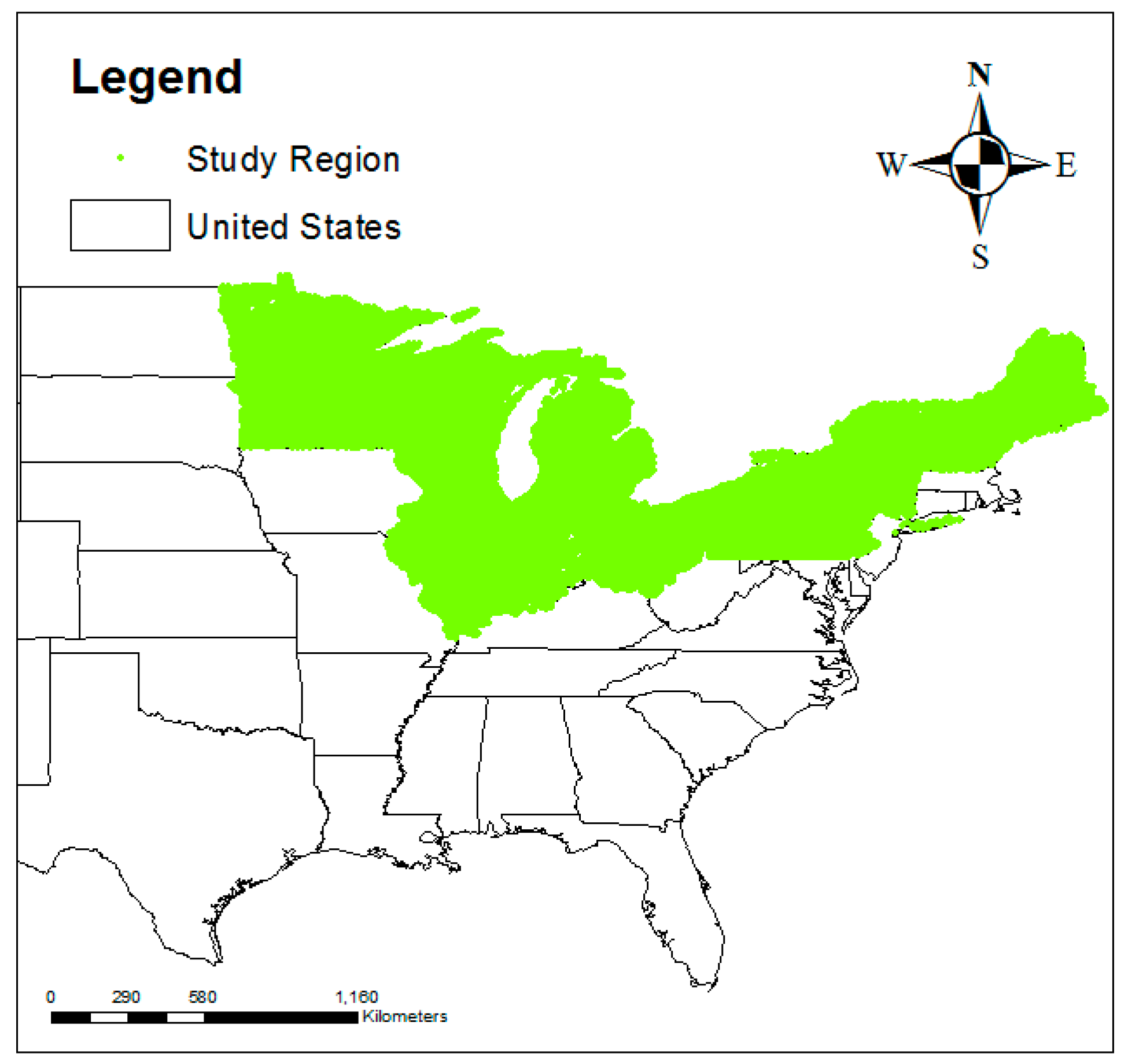
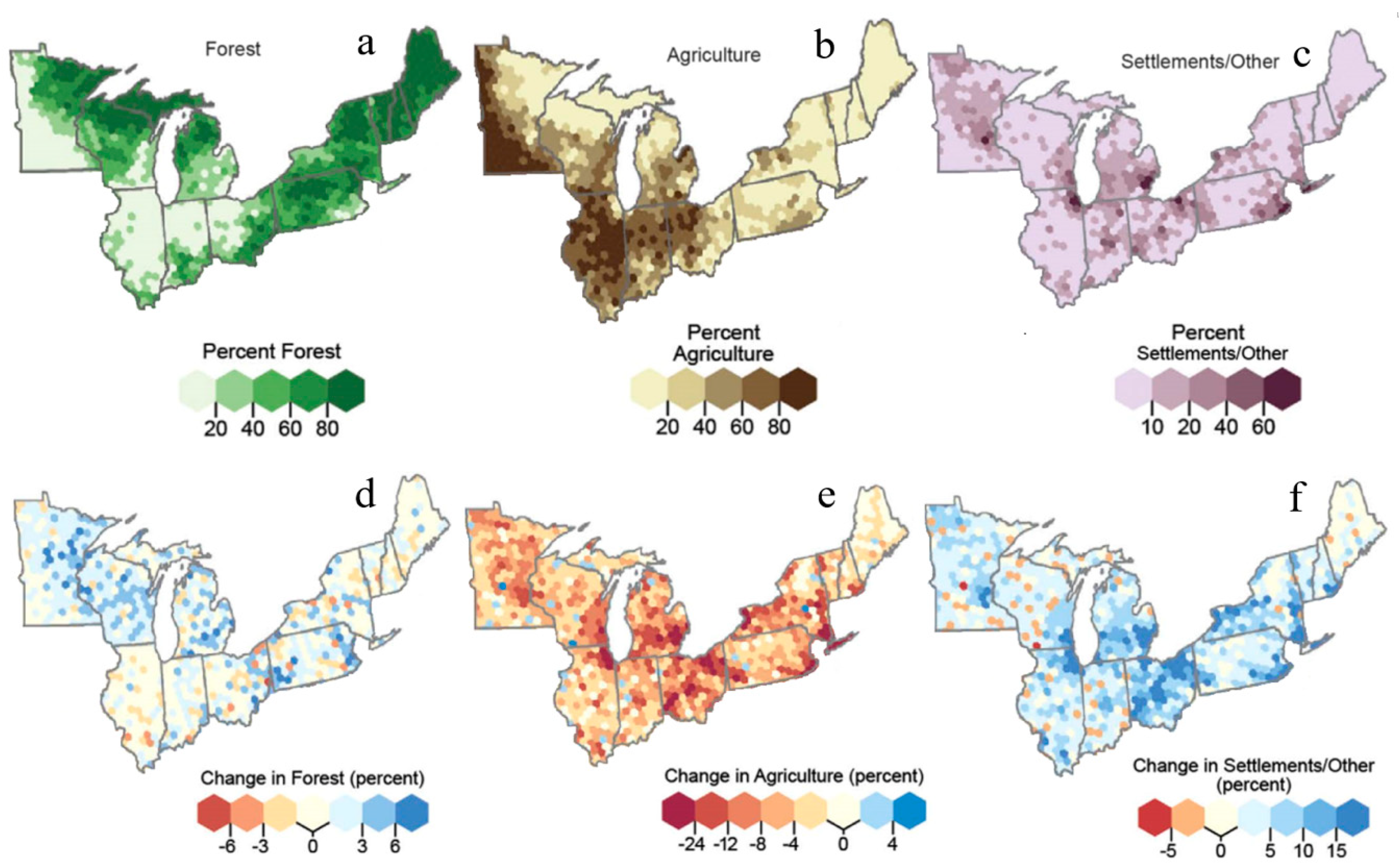


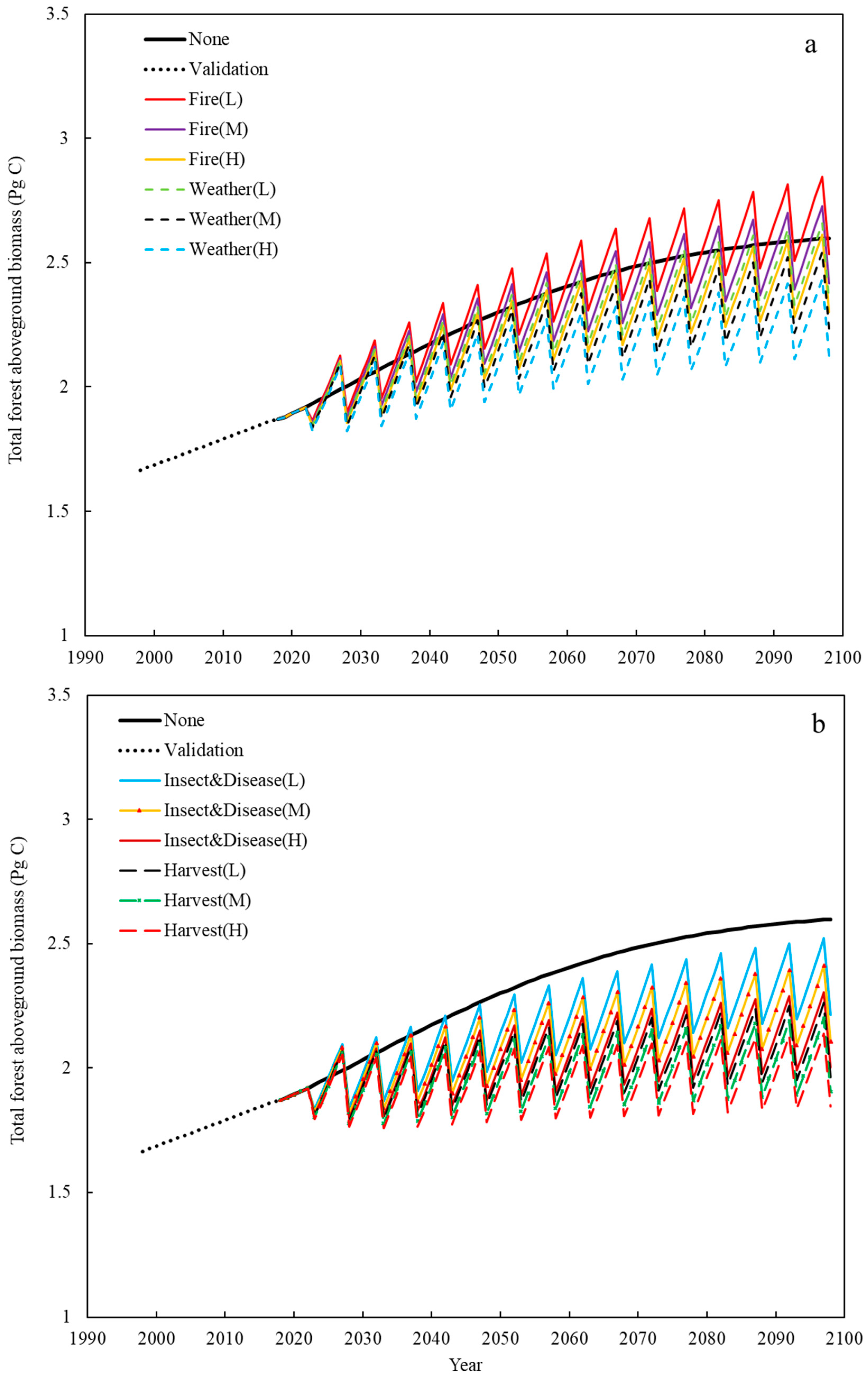
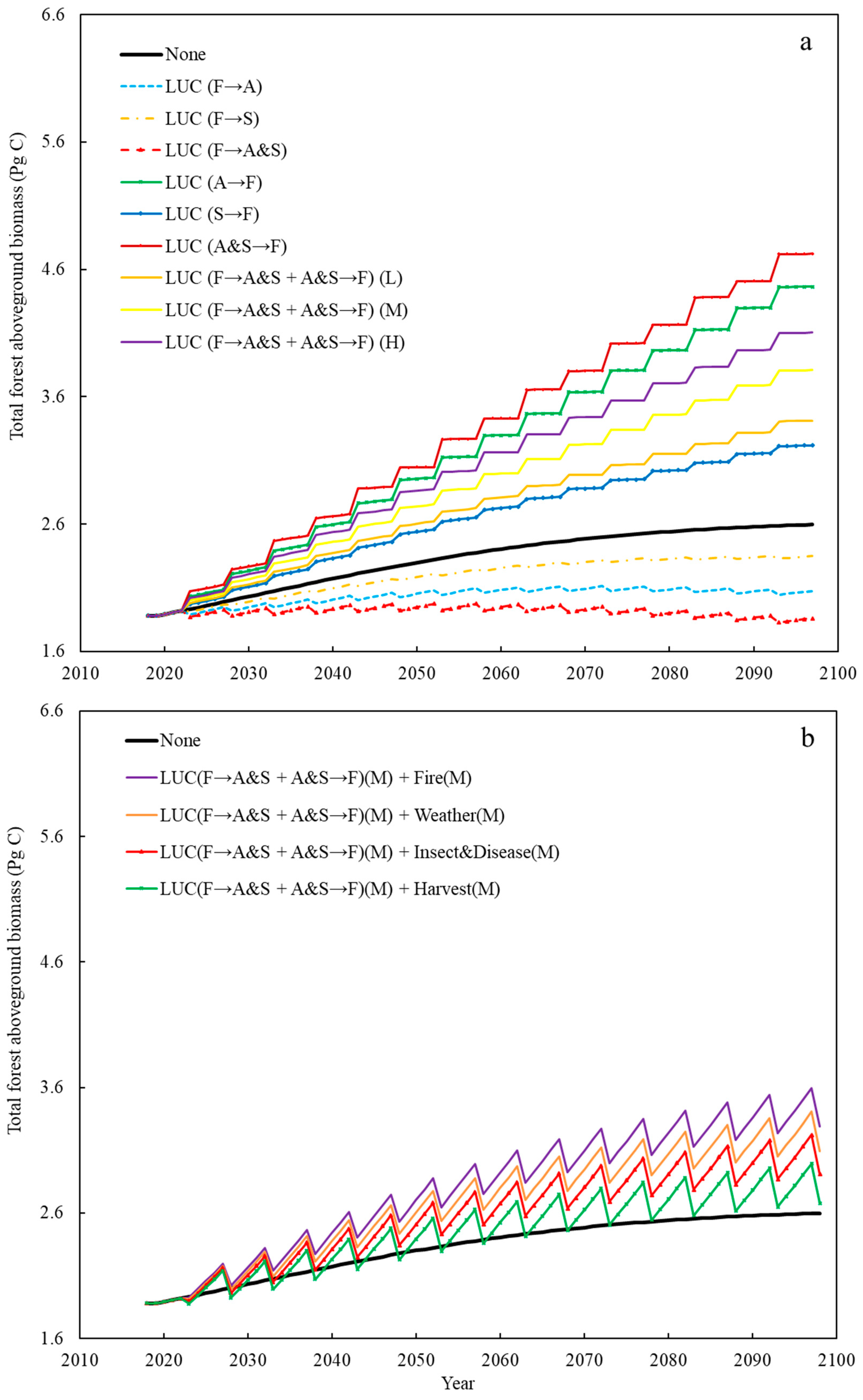
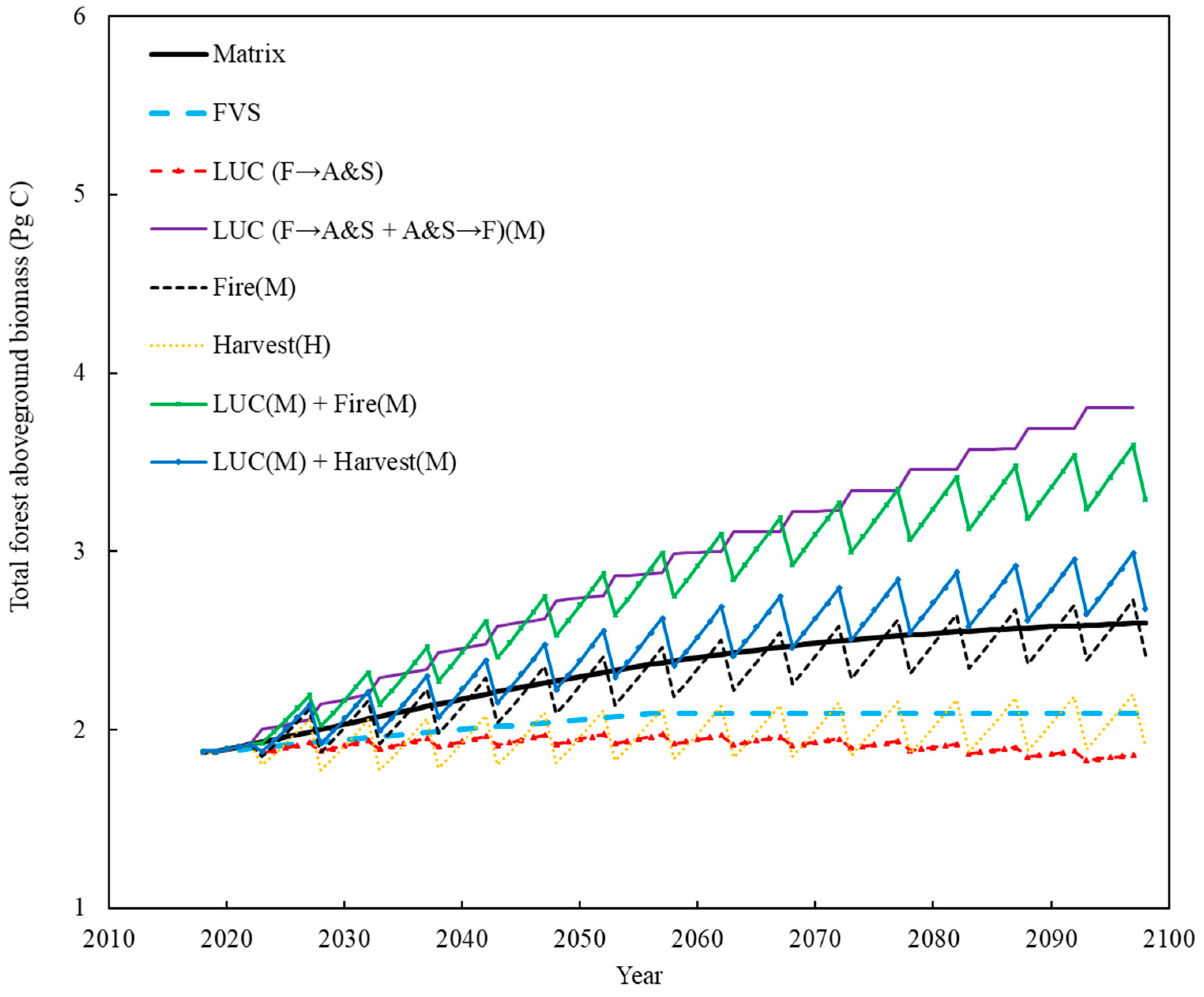
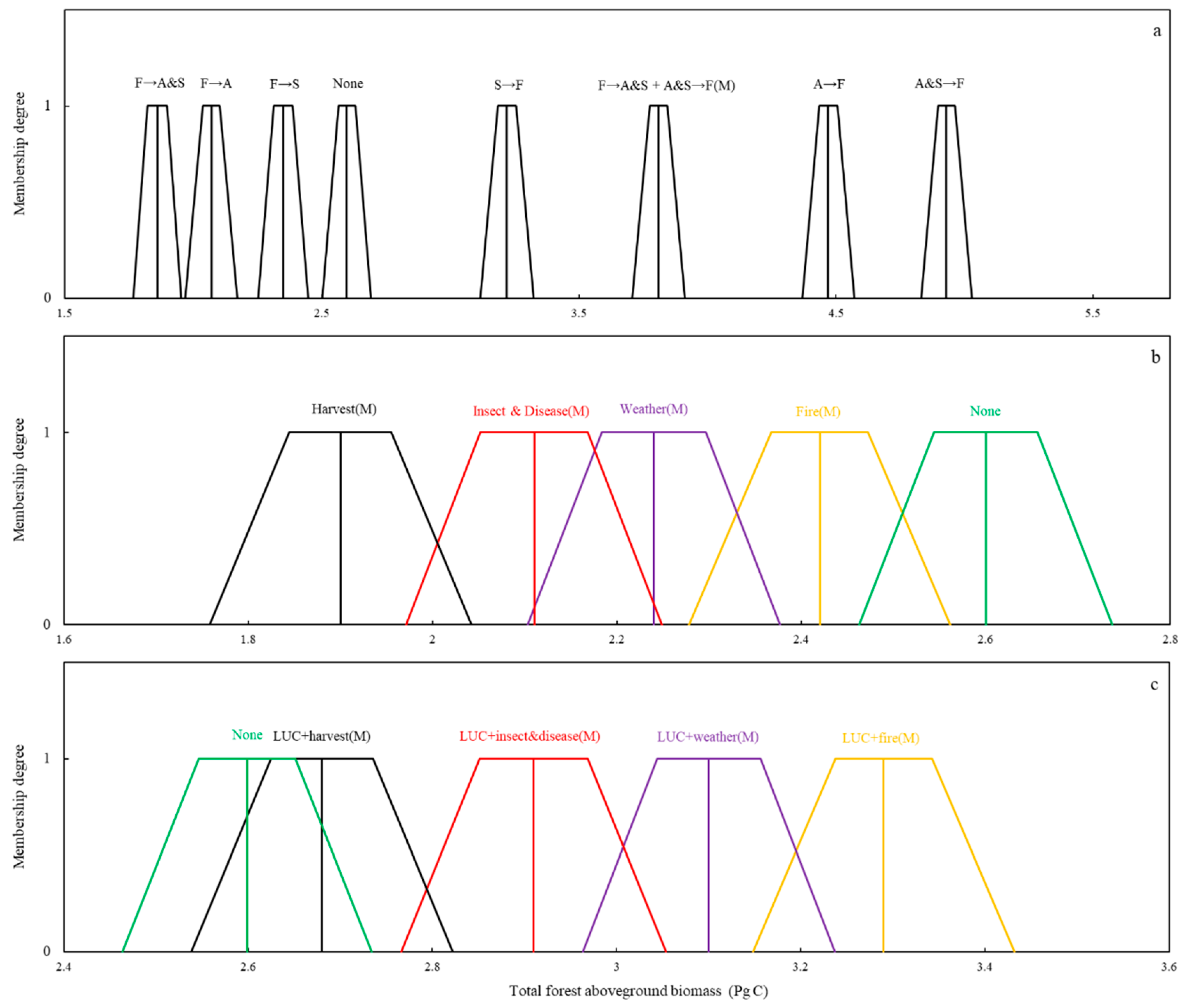
| Forest Area (ha) | F→A | F→S | F→A&S | A→F | S→F | A&S→F | F→A&S + A&S→F (Medium) |
| 331,711 | 408,482 | 740,193 | 946,968 | 323,456 | 1,270,424 | 530,231 |
| Variables | Units | Definitions/Explanations |
|---|---|---|
| Forest Inventory Data | ||
| AGB | Mg ha−1 | Aboveground biomass |
| B | m2 ha−1 | Total stand basal area |
| N | trees ha−1 | Number of trees per hectare |
| S E | km | Plot slope Elevation |
| Landsat Data | ||
| TCB | W m−2 | Tasseled cap brightness |
| DI | W m−2 | Disturbance index |
| EVI | unitless | Enhanced vegetation index |
| SWIR | nm | Shortwave infrared surface reflectance |
| TCG | W m−2 | Tasseled cap greenness |
| SAVI | unitless | Soil adjusted vegetation index |
| TCA | W m−2 | Tasseled cap angle |
| Diameter Growth Model |
| Deciduous |
| 0.521** − 0.176TCB* − 0.535DI* + 0.458EVI** + 0.233SWIR* − 0.818TCG** + 0.925SAVI* + 0.346TCA − 0.825E* − 0.668S* (R2 = 0.62) |
| Coniferous |
| 0.668** − 0.186TCB** − 0.719DI** + 0.389EVI* + 0.847SWIR − 0.279TCG* + 0.774SAVI** + 0.638TCA* − 0.796E** − 0.369S* (R2 = 0.59) |
| Mortality Model |
| Deciduous |
| 0.822* + 0.678TCB* − 0.846DI** − 0.868EVI** + 0.186SWIR* + 0.046TCG* + 0.798SAVI* − 0.337TCA* − 0.857E* − 0.668S** (R2 = 0.38) |
| Coniferous |
| 0.935* + 0.547TCB** − 0.869DI* − 0.845EVI** + 0.578SWIR* + 0.844TCG* + 0.362SAVI* − 0.878TCA* − 0.814E* − 0.667S (R2 = 0.35) |
| Recruitment Model |
| Deciduous |
| 0.667** − 0.879TCB* − 0.845DI** + 0.868EVI** + 0.887SWIR** + 0.935TCG* − 0.148SAVI* + 0.892TCA** − 0.146E − 0.756S* (R2 = 0.23) |
| Coniferous |
| 0.764** − 0.164TCB** − 0.396DI** + 0.446EVI** + 0.868SWIR* + 0.516TCG* − 0.593SAVI* + 0.827TCA − 0.357E** − 0.784S* (R2 = 0.21) |
| Aboveground Biomass Model |
| 0.368*** − 0.636TCB** − 0.768DI* + 0.234EVI** + 0.372SWIR* + 0.885TCG** + 0.936SAVI* + 0.185TCA* − 0.355E* − 0.885S** (R2 = 0.73) |
| Forest Area (%) | Harvest | Fire | Insect and Disease | Weather |
|---|---|---|---|---|
| Low | 6.0 | 0.5 | 3.4 | 2.3 |
| Medium | 7.0 | 1.5 | 4.4 | 3.3 |
| High | 8.0 | 2.5 | 5.4 | 4.3 |
| 2018 | 2028 | 2038 | 2048 | 2058 | 2068 | 2078 | 2088 | 2098 | |
|---|---|---|---|---|---|---|---|---|---|
| Low | |||||||||
| Harvest | 1.88 | 1.79 | 1.81 | 1.85 | 1.88 | 1.90 | 1.92 | 1.94 | 1.96 |
| Fire | 1.88 | 1.90 | 2.02 | 2.15 | 2.26 | 2.35 | 2.42 | 2.48 | 2.53 |
| I&D | 1.88 | 1.84 | 1.91 | 1.99 | 2.05 | 2.10 | 2.14 | 2.18 | 2.21 |
| Weather | 1.88 | 1.86 | 1.95 | 2.06 | 2.14 | 2.20 | 2.26 | 2.30 | 2.35 |
| Medium | |||||||||
| Harvest | 1.88 | 1.78 | 1.79 | 1.82 | 1.84 | 1.85 | 1.87 | 1.88 | 1.90 |
| Fire | 1.88 | 1.88 | 1.98 | 2.09 | 2.18 | 2.26 | 2.32 | 2.37 | 2.42 |
| I&D | 1.88 | 1.82 | 1.87 | 1.93 | 1.98 | 2.01 | 2.05 | 2.08 | 2.11 |
| Weather | 1.88 | 1.84 | 1.91 | 2.00 | 2.06 | 2.12 | 2.16 | 2.20 | 2.24 |
| High | |||||||||
| Harvest | 1.88 | 1.76 | 1.76 | 1.78 | 1.80 | 1.81 | 1.82 | 1.83 | 1.85 |
| Fire | 1.88 | 1.86 | 1.94 | 2.03 | 2.11 | 2.17 | 2.22 | 2.26 | 2.30 |
| I&D | 1.88 | 1.80 | 1.83 | 1.87 | 1.91 | 1.93 | 1.96 | 1.98 | 2.00 |
| Weather | 1.88 | 1.82 | 1.87 | 1.94 | 1.99 | 2.03 | 2.07 | 2.10 | 2.13 |
© 2019 by the authors. Licensee MDPI, Basel, Switzerland. This article is an open access article distributed under the terms and conditions of the Creative Commons Attribution (CC BY) license (http://creativecommons.org/licenses/by/4.0/).
Share and Cite
Ma, W.; Domke, G.M.; Woodall, C.W.; D’Amato, A.W. Land Use Changes, Disturbances, and Their Interactions on Future Forest Aboveground Biomass Dynamics in the Northern US. Forests 2019, 10, 606. https://doi.org/10.3390/f10070606
Ma W, Domke GM, Woodall CW, D’Amato AW. Land Use Changes, Disturbances, and Their Interactions on Future Forest Aboveground Biomass Dynamics in the Northern US. Forests. 2019; 10(7):606. https://doi.org/10.3390/f10070606
Chicago/Turabian StyleMa, Wu, Grant M. Domke, Christopher W. Woodall, and Anthony W. D’Amato. 2019. "Land Use Changes, Disturbances, and Their Interactions on Future Forest Aboveground Biomass Dynamics in the Northern US" Forests 10, no. 7: 606. https://doi.org/10.3390/f10070606
APA StyleMa, W., Domke, G. M., Woodall, C. W., & D’Amato, A. W. (2019). Land Use Changes, Disturbances, and Their Interactions on Future Forest Aboveground Biomass Dynamics in the Northern US. Forests, 10(7), 606. https://doi.org/10.3390/f10070606





